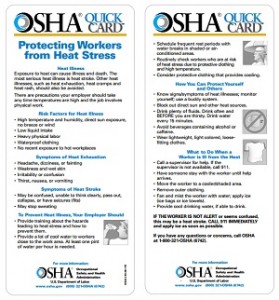Workers’ compensation laws make employers responsible for providing a safe work environment for their employees. If a worker is injured on the job, then the employer must pay medical expenses and make up for lost pay. During the summer months, this includes providing a place for workers to escape from the relentless heat of the day, including implementing mandatory water breaks. That’s because injuries on the job aren’t only limited to falls, strains, sprains or broken bones. Heat exhaustion and heat stroke are considered work-related illnesses if they occur during the performance of job duties.

OSHA Mandates to Protect Employer and Employee
A brief overview of OSHA recommendations regarding heat-related illness on the job is posted as an OSHA Quick Card, with useful tips that are easily accessible and understandable.
Some of the topics covered include:
- Symptoms of Heat Illness Some of the symptoms mentioned include headache, sudden onset fatigue, nausea, vomiting, and in extreme cases, lose of consciousness.
- Heat Exhaustion The first indications of a serious problem due to prolonged exposure to extreme heat can include seizures and passing out.
- Heat Stroke If signs of heat exhaustion and illness are ignored, a heat stroke is likely to occur. In rare cases, heat stroke can be fatal.
Using the OSHA Quick Card to Train Employees
The Quick Card contains useful information about heat illness and treatment, but it also gives some preventative measures to keep it from becoming an issue in the first place. Most of the tips are meant to encourage everyone to keep focus, stay hydrated and pair up with a work buddy to make sure heat illness doesn’t happen.
Who Has to Worry About Heatstroke?
In May of last year, an employee of the Sewon America auto parts plant in LaGrange, GA died of a heart attack, possibly brought on by heatstroke. During the same week, several other plant employees passed out due to the heat. The employee was forced to wait for several hours in an un-airconditioned break room before an ambulance was called. By that time, it was too late. Factory workers are not the only ones at a high risk for heat stroke. Construction workers, landscapers, farm workers, HVAC and golf course workers are all at risk.
How to Prevent Heatstroke Injuries
According to OSHA, best practices for working in hot weather or environments include:
- introducing new employees by gradual exposure
- allowing water breaks every fifteen minutes
- having rest breaks in a cooled rest area
- scheduling heaviest work during cooler hours of the morning
- training workers in the symptoms of heat stroke
- having a plan for first aid and calling for emergency help in the case of heat stroke
Employers can only control the work environment, but other things can affect whether an employee will have a heat illness. Workers’ weight, eating habits, alcohol consumption and even medications can all play a role in determining whether they are more likely to be adversely affected by heat in the workplace. The best an employer can do is to follow OSHA guidelines regarding how to provide a safe work environment. By utilizing the suggestions in the OSHA Quick Card, employers can cut the instances of heat illness down drastically. If you have been injured in the workplace due to an unsafe environment, contact workers’ compensation attorney John Snyder to obtain the compensation you deserve.





